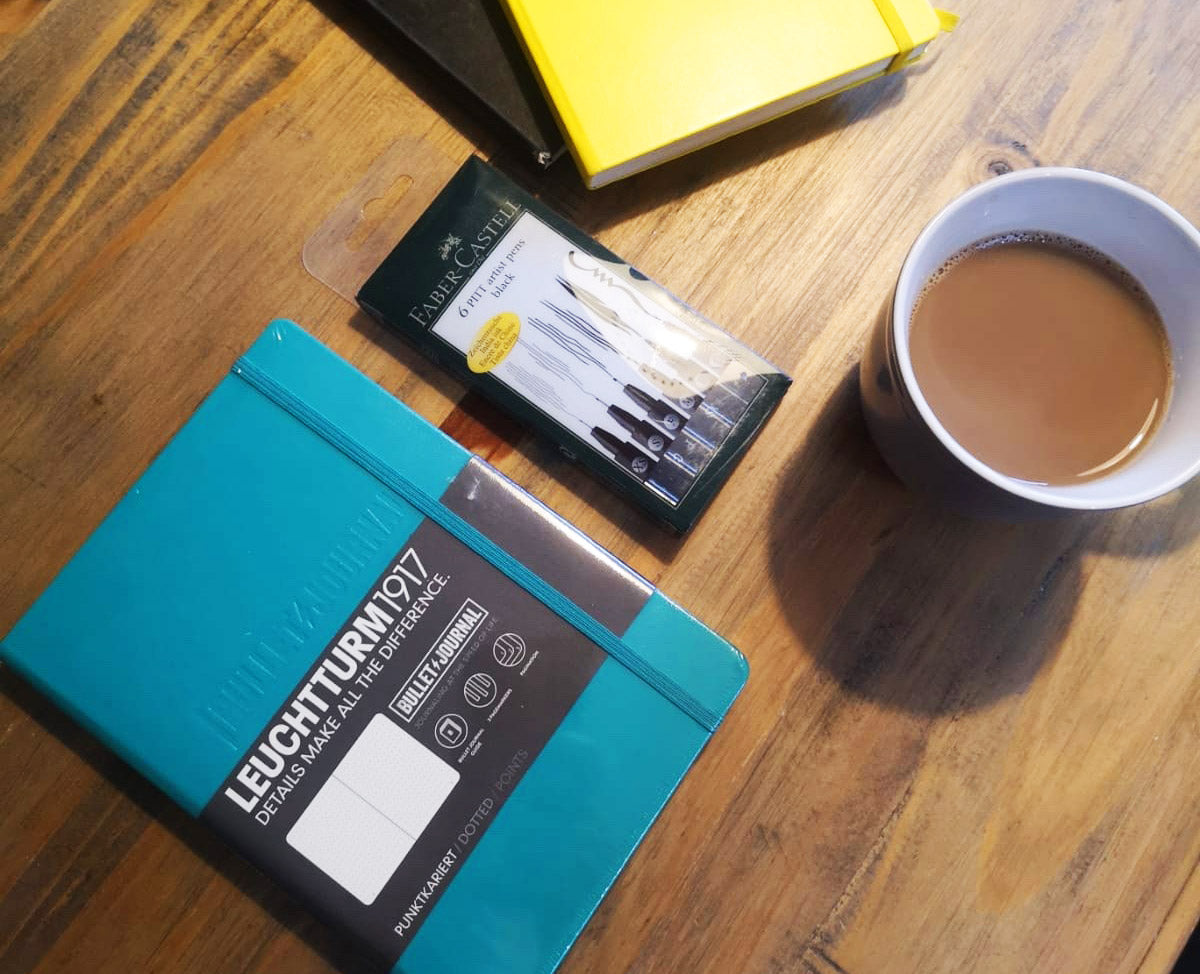We undoubtedly live in an age of digital experiences, faced with an endless stream of information leading to an existence of over-stimulation. This, when paired with an ever increasing pressure for a set version of ‘productivity’ within the workplace (much like a cheap bottle of plonk) can only lead to the physical and metaphorical headache many of us are all too familiar with.

The National Science Foundation suggests that we humans have between 12,000 and 50,000 thoughts per day! Include within that the numerous; appointments, deadlines, tasks, and to-do lists we manage daily … as well as those life events such as birthdays and anniversaries. Throw in the grind of bills, payments and responsibilities and you’d be forgiven for wanting to curl up under a duvet and hide from the world! 21st Century living is fast paced, digitally dominated and downright stressful at times. ‘What does this have to do with pens, pencils and stationery?’ I hear you cry! Well, within our world of writing tools and analogue devices there's somewhat of a respite. Stick with me on this!
Many of us make use of the multitude of online tools available to help organise and manage our lives, whether that's notes and calendar systems on our phones, apps to track activity, fancy tools to manage productivity or even social media platforms like Facebook, Instagram and Pinterest, all of which play a role in the compartmentalisation of our lives - from daily duties to our hopes, dreams and passions.

To BuJo or not to BuJo?
Now - as a disclaimer - I'm not suggesting a Neo-Luddism uprising but rather an exploration of Ryder Carroll’s Bullet Journal Method which has a huge following globally and promises to ‘track your past, order your present, and plan your future’.
If that sounds a bit airy-fairy to you, join the club! When I first began to explore the Bullet Journal Method (or BuJo if you are so inclined) I was sceptical of the testimonials claiming the method was ‘life changing’. I'm not saying that I'm ready to delete all my apps, discontinue my google calendar and commit to hard-core journaling, but there’s something in amongst the jargon and ‘self-help’ philosophies that sparks something in the monkey-brain in a delightful way.
This past year has seen self-care and mindfulness dominate with people such as Marie Kondo (of the KonMari method) tell us all that decluttering is necessary in the modern world and that if something doesn't ‘spark joy’ then its got to go.
Again, I won't be going home to shed my worldly belongings to gain a feeling of calm, but there is something in the concept of emphasising the things which bring us joy. This is something that Hamilton Pens has been practising for many years through the careful selection of writing instruments and accessories which appeal to us, whether to stock for sale or even in personal collections and passion projects. All of this marries together with the Bullet Journal in some way.
To set the scene for this discussion of ours, we received correspondence from the publishing house managing Ryder Carroll’s 2018 book ‘the bullet journal method’ which outlines the system and practice of the method itself. As stockists of the Leuchtturm1917 range of quality notebooks, specifically the A5 Hardcover Bullet journals, we were sent a copy of the book and a cheerful note about the method and how the book addresses this. Full disclosure...the book may have sat gathering dust for a while as so often happens in our busy lives, but having come across its mention a few times of late I decided to see what all the fuss is about...

What is a bullet journal?
The first thing to note is that the bullet journal system is a relatively straightforward idea and in practice is not necessarily time consuming or complex...however, many of the explanations and ‘tutorials’ (for lack of a better word) do a good job of making it seem terribly confusing and convoluted. The main idea is that you take a notebook and use it as the sole organisation tool, employing a menu of symbols and shorthand to allow for efficiency and organisational mastery. Where the KonMari method promotes the organisation of your physical space, the bullet journal method promotes a system of organising your thoughts, ideas and life in general.
Fundamentally, the bullet journal system states that by following a simple menu of rules you can adapt to create a journal to fit the way your brain works. Ultimately freeing up brain space to focus on the things that matter allowing you to think creatively, concentrating on things that are necessary or interesting to you rather than having to remember the menial things in life.
Sounds easy enough, what do I need to get started?
What are the basic tools needed? Well, a simple search of ‘bullet journals’ will find endless rainbow coloured, aesthetically intricate works of art...it is absolutely not a requirement but you can head in that direction if you are inclined for the artistic. It is generally advisable to get your head around the system first then you can personalise the system to your heart’s content.
All that you NEED to get started is a notebook and a pen.
As Ryder Carroll developed his system with Leuchtturm1917, the A5 bullet journal is perfectly suited to the task, though strictly speaking any notebook will do. The Leuchtturm1917 bullet journal features 240 numbered pages which removes the need to number each individually - which is a part of the process itself so already we are streamlining. The notebook is thread bound so can be opened flat to work within which adds ease to the exercise as well as containing stickers for labelling and archiving, an extendable pocket in the rear cover, ink proof acid free paper and the dotted pages that are immediately recognisable as a key feature of bullet journaling.

I personally would favour the Leuchtturm1917 but so long as you pick something around A5 in size so it's not so big it becomes cumbersome but not so small that it is not useful, preferably hardcover and something you will enjoy using you’ll be just fine, for example I'm a fan of the Castelli Honeycomb Copper notebook. The Castelli Arles could be a great alternative because of its removable notebook insert meaning you can continue with the same stylish outer for years to come.

Any pen will do the job but as you know pens are our passion so it would be remiss not to promote some of our top picks. For the pure joy of writing you can’t go wrong with an elegant fountain pen, for the purposes of this; Kaweco student, Parker Vector and Lamy Safari are a good selection as they are not so expensive that you would mourn its loss should it be misplaced whilst out and about, yet they are designed to be durable and high quality whilst retaining a striking appearance through pops of playful colour.

A ballpoint can be just as satisfying and the Caran d’Ache 849 classicline ballpoint is an excellent example, the hexagonal barrel is a joy to write with. For hard-core journaling or perhaps just a touch of fun, the Fisher pocket TEC space pens promise to allow for perfect flow whilst in the most extreme circumstances - whether this means you are making a list whilst swinging upside down or perhaps you are planning to bullet journal in the zero gravity vacuum of space! Regardless, a stylish writing instrument makes any task a joy.
Alternatively, a popular approach in bullet journaling is to use something like the kuretake bimoji cambio calligraphy brush pen to create stylish headings and focal points then using a favourite pen throughout the rest of the notes. Really it’s all down to individual choice - and the enjoyment of the writing experience
 I happened to have a pack of Faber-Castell PITT artist pens to hand so used the calligraphy pen and the 0.1mm XS for the set up of the bullet journal using the Leuchtturm1917 A5 bullet journal in emerald.
I happened to have a pack of Faber-Castell PITT artist pens to hand so used the calligraphy pen and the 0.1mm XS for the set up of the bullet journal using the Leuchtturm1917 A5 bullet journal in emerald.
Getting Started
So, now we have the tools for the job it's on to the process itself. The first step, as with many things, is preparation. This part of the process is the most time-consuming aspect but is essentially something that can be completed within an hour with a decent cuppa and a choice biscuit.
To break down the steps in brief, the first stage is to number pages ...this can be done in blocks, as you go along, or - if you have a numbered notebook such as the custom Leuchtturm 1917 Bullet Journal - you can skip this step.
The next thing to do is to create your index. This is where you pop all the contents of your journal so they are easily tracked. On the first two page spread of your chosen notebook title the pages Index - it’s as simple as that! Each time you add new content to your journal make a note of the title and page number in this index - its not rocket science (unless it IS rocket science!!!!)

The index is the first of the four core ‘collections’ required for bullet journaling. The next three are; the future log, the monthly log and the daily log.
The future log is used to store dated entries which occur outside of the current month. Whether you set this out as the current year or leave it more open is completely up to you and how you want to use the journal. Ryder himself promotes that a simple six month view is used but there are numerous creative ways to use this space, he states ‘everything we task ourselves with is a potential experience. The Future Log serves as your time machine, allowing you to glimpse the outlines of the future you're actively working towards’.

In short, title the first blank spread after the Index ‘future log’, section it as you please and populate each section accordingly. If you were to take the six month view, you may note key events such as birthdays, holidays and deadlines as well as any key things to remember. Then at the start of each new month as you set up the monthly log, check this future log to see if anything can be migrated across.


Speaking of the monthly log, this is the next core collection to set up. Again turn to the next blank spread in your journal and label it monthly log. On the left hand page list all the dates of the month and the initial of the day of the month, this serves as your calendar. Key actions should be noted here. This calendar is meant to be minimalist so entries should be succinct and used as a reference at-a-glance.
The right hand side of the monthly log should be set up as a tasks page. In short, this area of the journal helps take stock of the month ahead - what are the priorities? was there anything from last month that was incomplete that should rollover? This is where the philosophy of the method comes into play. Through setting up each monthly log at the beginning of a new month you allow yourself to reflect on the month that just passed. Did you achieve what you wanted to achieve, what happened that was fun or memorable? Are there things that fell by the wayside and if so are they really worthwhile to bring into the new month?


The final core section is the daily log, this is essentially the day-to-day section. Again you can use this in any way you see fit but you would begin with the date as the title (noting it in the index of course), you can begin by logging tasks or things to be remembered such as appointments by referring back to your monthly log. Then throughout the day, rapid log your tasks, events and notes as you go.

Rapid logging is a specific system employed by this method which essentially means writing things out in short so only the necessary information is noted. For example, if you were to make a note about having a meeting with Steve from accounting about the end of year taxes you might express this as : Meet Steve re EOY Tax. Detail can be added by nesting. So under an event you may list related tasks beneath- all of which using the bullet system.
The bullet journal takes its name from the use of stylised bullet points to represent certain types of content. As with everything in the method these can be personalised, but for purists: tasks are denoted with a simple bullet point, notes with a dash and events with an open circle. Many bullet journal enthusiasts will extend or adapt this list as well as using what Carroll calls signifiers. These basically appear on the left hand side of the ‘bullet’ type. An asterisk highlights the priority tasks so should be used sparingly, and exclamation points emphasise moments of inspiration, mantras, quotes or any strokes of attention you want to recall.

That is essentially all you need to get started! Many people also create their own ‘collections’ whether these are; books to read, places to visit, pens to collect or anything really! The system can be used to track progress with things such as learning a language, weight loss, habit building - essentially anything that is important to you.

You will find hundreds of examples online of people sharing the way they use their journals. The key aspect being that everything is kept in one place - so no more notes, post-its, apps and reminders all over the place - notes should be made by hand (any practice that takes us away from screen time is welcome in my eyes!) and that each month is ended by reflecting on the previous month and the undertaking the process of migration. I don't mean travelling south for the winter but rather the process outlined by Carroll whereby we weed out distractions and review our goals, tasks and all the bits we are noting by reviewing the pages of the month gone by.
It seems like a lot of effort to write everything out again but chances are you didn't get around to completing every single task in a given month so this process allows you to identify these and decide whether the tasks are important enough to migrate to the next month. The same goes for reviewing any ideas or anything that came up during the month to see if they should be moved to the future log or a monthly log
The purpose of the migration process is to identify what is worth the effort of rewriting, to become more self-aware of our actions and to separate out what is important from the noise that is modern living.
So although it seems like a faffy way to keep track of things, it really doesn’t need to take up much of your time. Each month you may spend around an hour migrating and setting up the month ahead and taking 10-20 minutes during an evening to write in your journal is a pleasant way to unplug and unwind. But to each their own!

Although this method seems rigid on the outset, it is more of a guideline for a system that works for many and that could be beneficial to you! The book that accompanied the creation of the method outlines the philosophies behind it more and delves into testimonials and stories of its creation. Many utilise the pages of the bullet journal to explore their goals and dreams, adding these to monthly logs or creating whole new collections for these.


I am yet to decide whether the bullet journal is something I will be adopting in the long term but I can certainly see the value for those who find themselves drowning in to-do lists, who enjoy the sensation of working pen to paper, people who are already driven by goal setting and those who enjoy creating in a systematic way. Plus, for me personally, the process of taking pen to paper is something that brings me endless joy and finding a way to take that experience and try and organise my world in a more analogue way is satisfying and feels purposeful. In short, I will be using the bullet journal for the next few weeks, perhaps not in the purest sense with the rapid logging shorthand but as more of a mezze board to pick and chose from, slowing down in a fast paced world and going back to the days I would sit scratching away thoughts and ideas.



